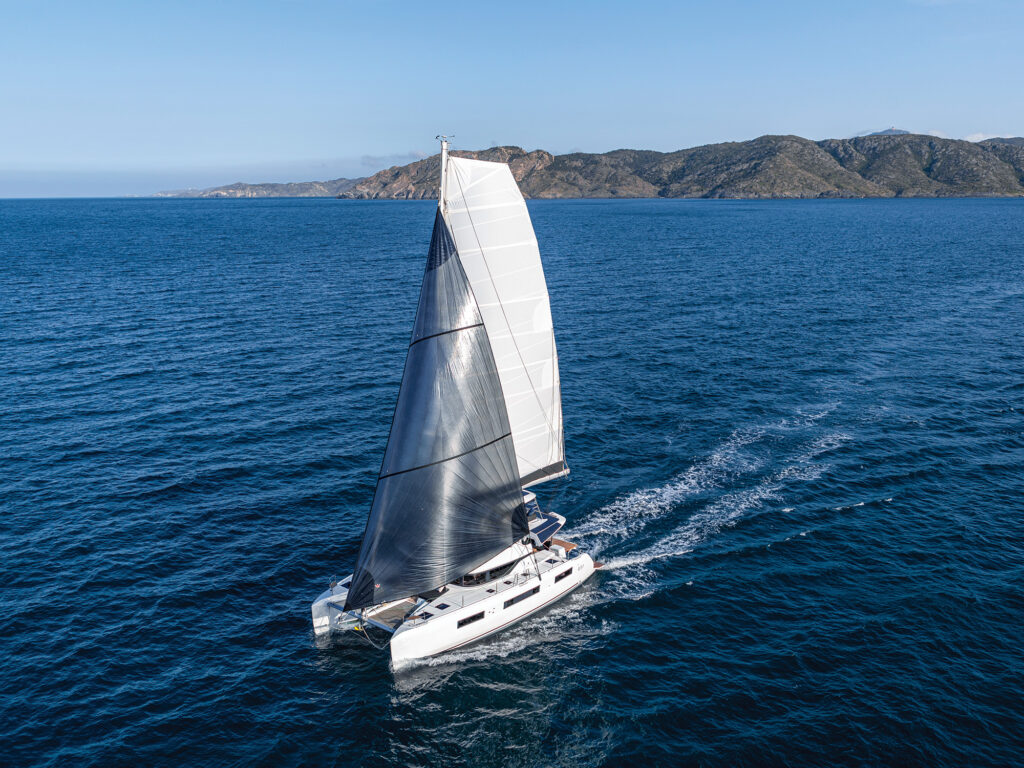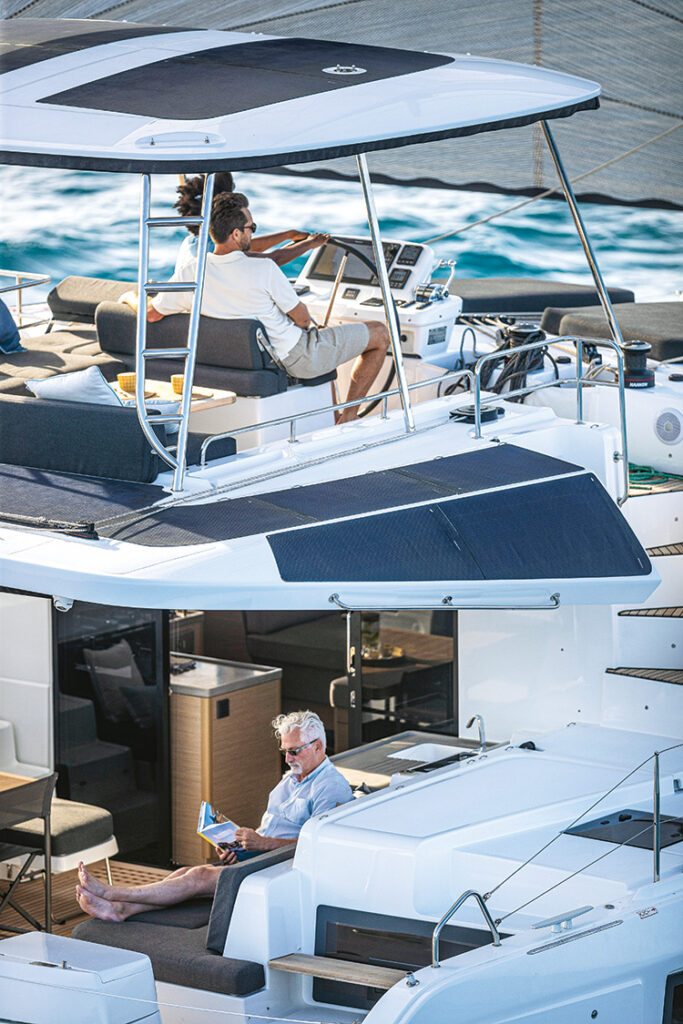Boat Review: Lagoon 51

With a bright and inviting interior, numerous on-deck places to relax or socialize, good sailing manners, and a versatile array of layouts for couples, families or chartering, the Lagoon 51 does a number of things right.
The 51, designed by Lagoon’s longtime naval architect collaborators at VPLP Design, replaces the Lagoon 50, which was introduced roughly five years ago. The new model lands dead center in the company’s lineup of cruising catamarans that range from 40 to 77 feet. The Lagoon 50 is the largest model intended for an owner-operator; starting with the Lagoon 55, there’s likely to be a captain and/or crew involved.
The company, which builds some 275 boats a year, projects that it will build 45 to 50 hulls of the new 51, with about a third sold for private use and the remainder going into charter. With that in mind, it makes sense that the interior design of the 51 includes multiple accommodations layouts.
The four-stateroom version is more likely to appeal to a private owner, whose suite takes the entire starboard hull. It has a queen-size berth aft that’s adjacent to one of three rectangular ports in the hull, providing a tremendous view of the world outdoors. Amidships, there’s a desk and seating area outboard with a view. Opposite are hanging lockers along with a walk-in closet/dressing room. A head and shower are forward, and are kept bright in daylight hours with natural light.
Three guest staterooms occupy the port hull. The aft stateroom has an en suite head and shower. The remaining two staterooms—one forward and the other located inboard and amidships—share a head and shower.
A four-stateroom, four-head version is also available, and there’s a charter-friendly six-stateroom, four-head option as well.
The 51 is built in Lagoon’s yard in Bordeaux, France, on the same production line as the Lagoon 55. Lagoon infuses its balsa-cored composite hulls and decks, a process that helps to control weight during construction. The Bimini top over the flybridge is injection-molded. The 51 has a 12-volt electrical system.

On recent Lagoon models, VPLP designers placed the mast farther aft than on older models, employing a shorter boom and high-aspect main, a trend made popular on big racing multihulls. On those boats, race crews rely on a quiver of headsails, often set on furlers, to quickly power up or down the sail plan to match conditions. Most cruisers and charter boats, though, are rigged with a single jib or small genoa, a setup that can affect performance in light conditions. On the 51, Lagoon returned the rig to a more forward position, and the mainsail will be cut for a bit more power. This should mean better performance in light air. Moving the mast ahead also opens up space in the salon.
Another interesting design choice on the 51 is the placement of large transoms on either side of a swim platform that can be lowered into the water at anchor, or be raised and used to store a tender underway. The oversize transoms extend abaft the sides of the hull, making it easier to step aboard from a dock or tender. And they make a good place to sit and dangle your feet in the water.
There are essentially four places to congregate on the 51. A padded, U-shaped seating area is on the foredeck, with a window abaft it that opens from the salon, and through which snacks can be passed. That window also provides increased indoor ventilation.
The open salon has a galley aft with L-shaped counters on either side of the sliding cockpit door. Stove, oven and sink are to port; fridges and freezer drawers are to starboard. There is a side-facing nav desk in the forward starboard corner, adjacent to a dining table with seating all around. Visibility is great forward, aft and to either side, thanks to Lagoon’s signature vertical windows.
The cockpit offers a second alfresco dining option, with a table to port. A sun lounge is opposite, and more couch-style seating is across the stern between transom stairs. There’s an outdoor sink too, along with a fridge and ice maker.
The real party place, though, is one level up, on the flybridge. My guess is that’s where people will hang out most of the time.
There is access to the flybridge from the cockpit below via steps on the port side next to the outdoor dining table, or from the starboard deck. The helm station with a bench seat is forward; abaft it is U-shaped seating surrounding a cocktail table. A pair of sun pads is forward of the helm on the cabin top, on either side of the mast.
I know there’s debate about whether flybridge steering is better for chartering than long-range cruising, when a helmsman might prefer to be more protected from the elements, but on the 51, I really liked the flybridge setup. First off, there’s good all-round visibility. Second, the person driving has space to work but can still be part of the conversation.
Three Harken electric winches are within an arm’s reach of the wheel, and all sail-control lines except for the traveler are led to them (there’s a Harken side-wind winch for the traveler nearby). During my trick at the wheel, I found that tacking the boat singlehanded was quite easy. Underway, a window overhead in the Bimini top gives the skipper a clear view of the square-top mainsail. That’s a nice feature when trimming or hoisting sail. One caveat, however: The combination of flybridge and Bimini top means the height of the boom is fairly high off the water.
Though it was not available on the boat that our team got aboard in Annapolis, Maryland, a unique roller-furler boom is available for the 51. Lagoon developed it in conjunction with Wichard and Incidence Sails. Buyers can watch a video of it in action.
As I said at the start, the 51 has good sailing manners. In 10 to 14 knots of breeze, we saw speeds in the low 6s closehauled and nearly 7 knots on a broad reach. The top speed of the day that I jotted down in my notebook was just over 7.5 knots. In these conditions, it would have been fun to roll out a big reaching sail, if we’d had one. The boat is set up for it with an aluminum sprit.
With the 51, Lagoon has what I might call a Goldilocks boat: not too big, not too small, capable for cruising, and comfortable for chartering. In a lot of ways, it’s pretty much just right.
Mark Pillsbury is a CW editor at large and was a 2024 Boat of the Year judge.
Toward a Green(er) Machine
From resin and cloth to solar power and more-efficient systems, the Lagoon 51 takes advantage of ongoing development work that Groupe Beneteau employs across its many brands to make boats cleaner to construct and operate.
Let’s face it: While the act of sailing might be considered a green pastime, building boats definitely isn’t. A lot of resin, fiberglass, adhesives, and sealants are required to build a structure that’s 50 feet long, nearly 27 feet wide, and three stories tall—and strong enough to hold its own in a bluewater environment.
A boat that size needs a pair of beefy (80 hp) diesel engines for motoring. And it has numerous energy-gobbling systems and appliances such as air conditioning, fridges and freezers, a washer and dryer, and the like, all of which need to be fed.
Any steps toward greater sustainability are strides in the right direction. With the 51, Lagoon began to add bio-sourced resin when laying up nonstructural small parts. In place of fiberglass cloth, the company is experimenting with natural fibers such as hemp and linen. And for years now, Lagoon has infused its hulls, which allows better control of the resin while reducing vapors released into the atmosphere.
An array of custom XXL solar panels—more than 3,400 watts’ worth—line the perimeter of the flybridge and its hard Bimini top, helping to reduce (or eliminate, if the air conditioner is not on) the amount of engine (or diesel generator) run time needed to keep the battery bank topped up. Adding to the power equation is the use of more-efficient cooling units and LED lighting.
Throughout the boat, Forest Stewardship Council-approved Alpi wood is used, and upholstery is made from 100 percent recycled materials. New Lagoons come with eco-friendly cleaning products. Starting this year, the boats also will be equipped with UV water filters to reduce the need for single-use plastic bottles for drinking water.
“In a nutshell, Lagoon is committed to sustainability through various initiatives such as using FSC-certified wood, recycled materials for upholstery, and bio-sourced resins,” says Lagoon Americas director Andre Hernandez. “Our production sites are ISO-certified for environmental management. We incorporate XXL solar panels on our boats and offer biodegradable maintenance kits. Lagoon also invests in hybrid-propulsion research and supports projects such as Anima Mundi and Escape to Nature to promote environmental conservation.” —MP
The post Boat Review: Lagoon 51 appeared first on Cruising World.

